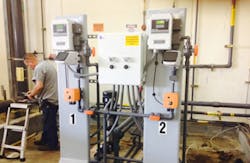By Cliff Lebowitz
Red-bleach dosage delivery is controlled from the plant’s supervisory control and data acquisition (SCADA) terminal, adds Richard. Capacity of the reverse osmosis facility is 7.5 million gallons per day (mgd). The surface-water, advanced-treatment system (SWATS) plant at Granbury is operated by the Brazos Regional Public Utility Agency.
"We only got close to what we needed by running the pump at 100 percent capacity, which caused excessive vibration throughout the bleach delivery system and consequent frequent leakage in its valves and piping," recalls Richard.
"Even then, we were always 1.5 gallons short of the 4-gallons per minute of bleach that we needed to give us the 250 mg/L we wanted in the chemical backwash for the ultra-filtration membranes," Richard added. "We looked at different pumps and decided to try the vacuum feeder. It’s been running for over a year now, and we haven’t had to do any plumbing work in the bleach delivery system — no leaks, repairs, nothing — and we’re finally getting the dosage we need."
Getting it right
The ultrafiltration system is used as a pre-treatment for the reverse-osmosis facility whose output is blended with raw water that has passed through conventional clarification and gravity-sand filtration treatment. It allows for production of feed water to the reverse-osmosis system at a silt density index of <3. The blended water is to feature chlorides below 100-150 parts per million.
"I can also now control bleach dosage from my SCADA terminal, which I couldn’t do before," says Richard. "I have a very small footprint for the bleach delivery mechanism compared to what I used to have; and clean-in-place frequency has been greatly reduced."
The contribution of the different sources to finished water varies with raw water flow and quality, especially regarding turbidity and taste or odor. The finished water is sold to two separate utility districts that supply about 70,000 end users, mostly residential, but some commercial as well.
The JCS Industries chemical feeder used at the SWATS plant gathers real-time feed information via electronic flow sensors that allow for continuous monitoring and control of the chemical feed rates. Feeder operation is automatic in both fixed and variable control modes, including fixed feed rate, flow-paced, residual-control and compound-loop.
Decade’s history
The ultrafiltration and reverse-osmosis units, added in 2002, eliminated chlorides use. In 2007, ultrafiltration expanded to five skids and from 6.5 mgd to 7.5 mgd. The same thing was done for the reverse-osmosis system in 2009.
"The bleach pump always shorted us on what we wanted from it, even when run at the 100 percent capacity we were only getting 180 mg/L of the 250 mg/L of bleach that we needed in the ultrafiltration chemical backwash," Richard says.
"As a result, the membranes weren’t clean enough. Trans-membrane pressure would climb and cleaning-in-place was required more often, almost every month," he continues. Clean-in-place is now done about once every six months.
"We thought about peristaltic pumps as a replacement, but they wouldn’t overcome the back pressure on the backwash system," he says. "Fortunately, a former co-worker told us about this new vacuum-feeding method, and we put it on trial. Right away we saw that with really only one moving part vibration was negligible."
The system vacuum injector safely introduces the liquid into the feed-water stream; a reversing servo motor coupled with a V-notch valve regulates the chemical feed rate; an electronic flow sensor monitors and regulates the feed rate; and a control module is for electronics and communications.
"We plan to continue to use this technology for the bleach feed system and will probably be trying it for other chemicals as well." The feeder system can dose a variety of aqueous chemicals commonly used in municipal and industrial water treatment systems.
Water-flow or chemical-residual rates establish the chemical flow rate — with a servomotor moving the feed valve. Ratio of input signal to liquid flow adjusts over a range of 5 percent to 400 percent to enable increased liquid feed in response to additional chemical demand.
The all-vacuum liquid feeder can dose up to 60,000 gallons per day.
JCS Industries of Spring, Texas, is maker of the Model 4100 liquid vacuum chemical feeder. For further information, telephone 281-353-2100, [email protected] or www.jcsindustries.us.com.

